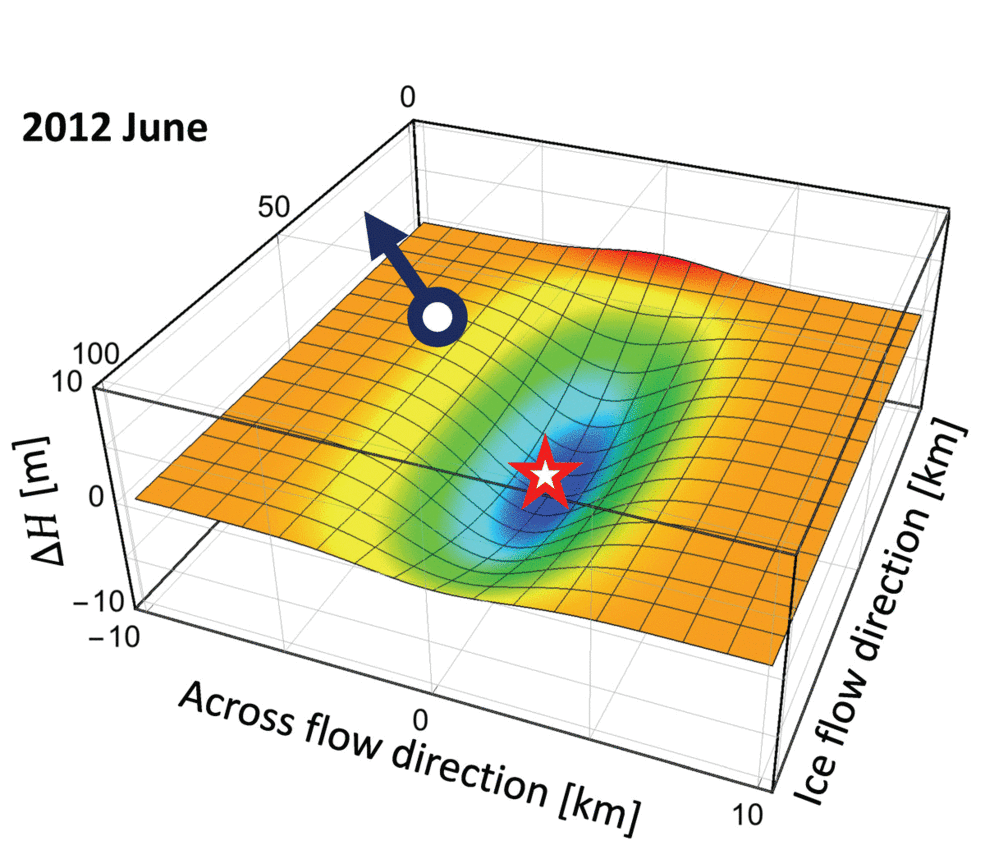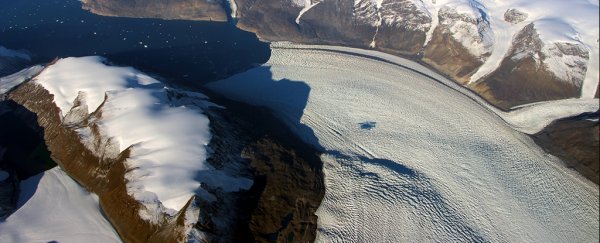In the middle of two of Greenland's hottest ever summers researchers detected for the first time a build-up of ice slipping down the length of one of the island's glaciers in a single wave.
In a never before seen melting process, scientists from NASA's Jet Propulsion Laboratory (JPL) in California detected a pulse of ice so big the crust underneath bent in a wave as it passed.
Rink Glacier on Greenland's west coast isn't Greenland's biggest glacier, but it is a major outlet for the build-up of ice and snow that falls on the island every year.
During the early 2000s, about 11 billion tons of ice flowed from the glacier into the sea each year.
Yet in 2012, more than half of that amount was added on top of the usual flow, toppling from the icy conveyor belt into the sea in the form of a solitary wave.
To better understand what was going on, a small group of scientists from NASA's Jet Propulsion Laboratory in California tracked the movement of mass inside a glacier by watching the subtle shift in a global positioning satellite (GPS) sensor located near the glacier.
The sensor's tiny sideways migration of just 15 millimetres indicated the bedrock beneath was being warped as the mass of the nearby glacier increased and then decreased over the course of about four months.
"You could literally be standing there and you would not see any indication of the wave," said researcher Eric Larour. "You would not see cracks or other unique surface features."
The research paints a picture of 6.68 billion tons of ice slipping down the length of the glacier, at an average speed of about 7.1 kilometres (4.4 miles) per month in a gradual process the scientists compared to a warmed popsicle "sliding out of its plastic casing".
Compared with Rink Glacier's leisurely several kilometres (1 or 2 miles) per year, this can only be described as a wave rippling through a glacier at breakneck speed.
Two years earlier, in Greenland's second hottest summer, the sensor showed a similar dip, though one that was slightly smaller.
This animated gives you some idea of the movement of the mass over the months.
 NASA/JPL-Caltech
NASA/JPL-Caltech
While the researchers are confident they know the cause, they still aren't entirely sure of the details behind the process.
"We know for sure that the triggering mechanism was the surface melting of snow and ice, but we do not fully understand the complex array of processes that generate solitary waves," said lead researcher Surendra Adhikari.
They aren't short on ideas, however. It's likely a bunch of well understood melting mechanisms are going on, adding up to cause a rapid wave of melting ice.
As warm as 2012 was, there was plenty of ice and snow piling up high in its mountains. So as the temperatures climbed, more than 95 percent of the ice was starting to melt.
"The water upstream probably had to carve new channels to drain," said Ivins. "It was likely to be slow-moving and inefficient."
Glaciers don't just melt under the glare of the Sun – as water trickles down to its base, it can hasten the melting underneath, lubricating the river of ice above and allowing it to slip downstream even faster.
A faster than usual melt caused by a rush of water could see the glacier downstream slip faster than the build-up of ice upstream. In other words, the glacier stretched over summer, and the wave was ice deposited from October to January catching up.
"This systematic transport of ice in fall to midwinter had not been previously recognized," Adhikari said.
NASA has estimated that about 287 billion tons of ice tips into the ocean from Greenland's coast every year, so another 6.7 billion tons from one glacier might not seem like a lot.
But if it's a sign of things to come, we have a lot to be concerned about.
"Intense melting such as we saw in 2010 and 2012 is without precedent, but it represents the kind of behaviour that we might expect in the future in a warming climate," said Ivins.
"We're seeing an evolving system."
To put Greenland's substantial ice sheet into perspective, losing it all in one go would add 7 metres (about 21 feet) to sea levels, not to mention cause havoc with ocean currents by dumping in a load of cold, fresh water.
The network of GPS sensors currently aren't being maintained by any one agency, so a discovery like this is a wake-up call showing how useful they could be in monitoring Greenland's glaciers.
Novel uses of technology such as this will help us tune our models as we learn more about how our world is adjusting to a slowly warming climate.
This research was published in Geophysical Research Letters.
